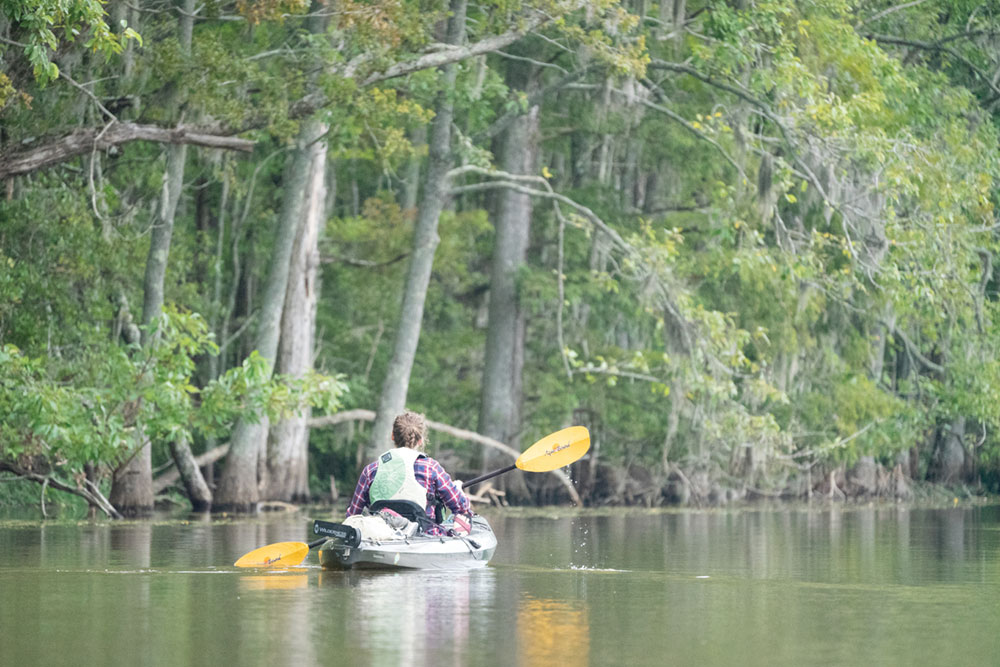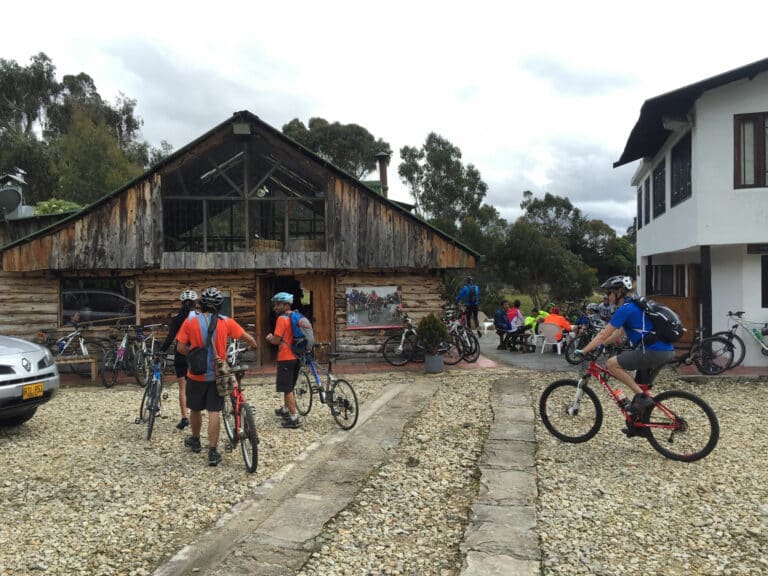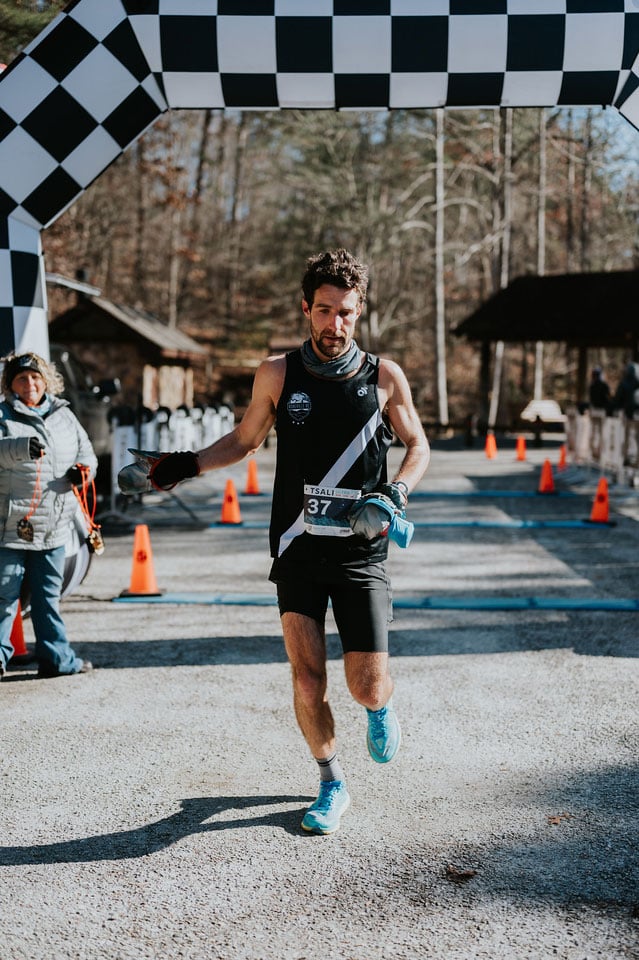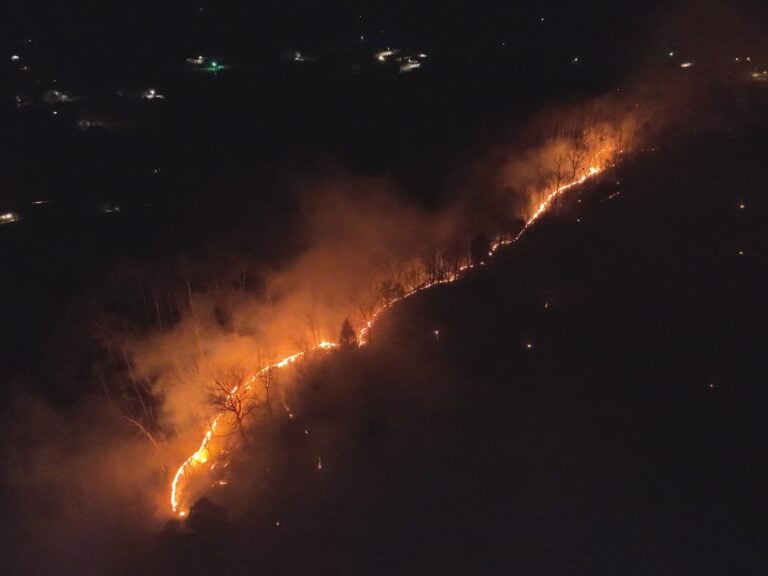During times of hardship, community leaders in North Carolina look again to the Roanoke River
The Roanoke River passes under I-95 at mile marker 173. Here, just north of the town of Weldon (known as the Rockfish Capital of the World), the river comes apart like string cheese, tumbling down the fall line to create the Roanoke Rapids, fast and foamy and scenic as hell. Hard as it is to believe, this isn’t even the wildest part of the river, the part that locals call “the Amazon of North Carolina.” To find that place, you have to get off the interstate. You have to drive down narrow country roads, framed by cotton and peanuts and sun-bleached houses covered in pine straw. Past the shuttered mills and the playhouse-sized church with a sign out front, a warning to spiritual procrastinators: “church doors closed do [sic] to rapture.” Beyond the bypass and straight into the heart of the old, old South.
Here—in rural Bertie, Martin, and Washington Counties—the Roanoke swells into an enormous flood plain, feeding blackwater swamps where birds find sanctuary and cypress trees reach from the ground like zombies at night. And in the middle of all that untouched wilderness, something else: camping platforms. Fifteen simple, square structures placed at intervals along the river and its cola-colored tributaries, accessible only by boat and anyone looking for a singular outdoor experience.
“Those are our carrots,” says Carol Shields, director of Roanoke River Partners, the organization that built those platforms almost 25 years ago. “That’s what brings people to us.”
Shields and her group are not adventure outfitters. They are not river keepers, although they do care deeply about the preservation of this place. Before eco-tourism was a hashtag—RRP was luring paddlers to the river and, more importantly, the region, trying to fill the calamitous void created by the exodus of the textile industry and the near-extinction of the area’s small farms. Before eco-tourism was a hashtag—heck, RRP was luring paddlers to the river and, more importantly, the region, trying to fill the calamitous void created by the exodus of the textile industry and the near-extinction of the area’s small farms.
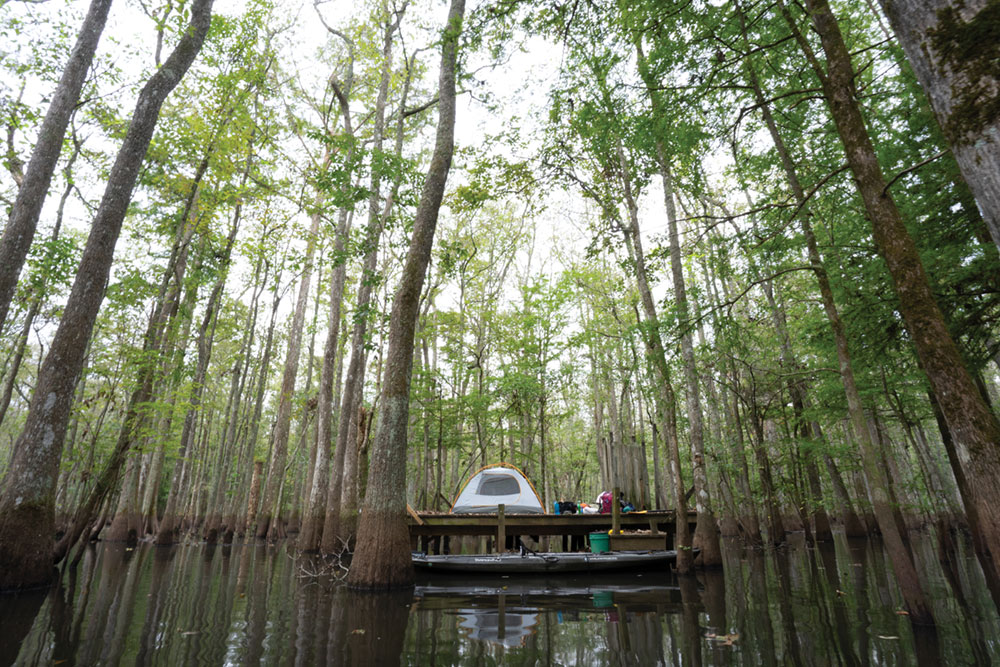
Building camping platforms, they hoped, would be like building a new economic infrastructure: one that revolved around a commodity that couldn’t be outsourced to Mexico or pummeled by a Walmart on the four-lane. Bait that would draw curious visitors to eastern North Carolina where, after docking their boats, they would wander into local cafes, motels, and shops, pouring money and pride back into the communities they found. It’s a common enough strategy now, but back then, it was wholly original—and unproven.
And while they couldn’t reverse globalization or resurrect family farms, the platforms have worked. I know this because I saw a blurb about them in a glossy magazine a few years ago, and I did it: I bit the carrot.
The Roanoke River is some magic combination—both startlingly remote and remarkably accessible. In the 130-ish miles that the RRP works on, paddlers will find a dozen access points with parking lots, boat ramps, and signage, making it possible to plan a trip with one car and no outside help.
My boyfriend Jeff and I began our journey at an access point in the tiny, tidy town of Williamston, where we met Captain Heber (Hee-ber) Coltrain, the one-man team behind Roanoke River Adventures and our shuttle for the weekend. With big, round eyebrows and a coastal-plains accent that steamrolled my Yankee heart, Coltrain wasted no time in regaling us with the vibrant history of the region: the nearby Tuscarora reservation, some Aaron Burr-related drama, an old WWII POW camp.
Before we set sail, Coltrain held court on the hood of his truck. He brought us a map, and a breakout map, too, and traced a pencil along the route he had planned for us. Coltrain has been on the river ever since his daddy plopped him into the family’s homemade plank boat, propelled by a 1953 Western Auto Wizard engine. The landmarks he tells us to look out for are decidedly…intimate: rusted metal peeking from the woods, crumbling hunting shacks, variations in the tree line.
And then, we were alone—unless you count the bald eagle we spotted immediately, drawing circles in the sky. Or the juvenile eagle that watched suspiciously from a sycamore. Or the sliders crashing off every sunny log we approached. Welcome to the Amazon of North Carolina, we thought, our oars forgotten in our fists.
Thanks to some recent rain, the river did most of the work for the first two miles. At a drop in the tree line, just like Coltrain had instructed, we aimed starboard into Devil’s Gut, a straight or maybe a slough that was downright rowdy with wildlife. The cypress closed in, the current slackened, and immature ibises pooped in the water from the branches above. Kingfishers rattled by, doing a sweep of the perimeter. A few hours and a full memory card later, we followed the signs to our first destination, Barred Owl Roost, a 20 x 20 wooden platform that rises from the swamp, ethereal as a raft afloat on the sea.
Fires are prohibited on the platform, so dinner was a quick affair. Soon we were tucked in with headlamps and books. Before the sun even set, the platform’s namesake birds were warming up—Who cooks for you? —answered quickly by the pterodactyl screams of a great blue heron.
I have slept in the yawning expanse of the Badlands, in the alpine silence of the Great Basin, but I have never felt as alone as I did on that platform, which is kind of ironic because I spent most of the evening considering the lives adjacent to the river. Not just the owls and the herons, but the people who have relied on the Roanoke, present and long gone.
I thought about the first Roanoke River Partners meeting that Carol Shields described, back in 1997. A group of local officials, business leaders, and concerned citizens gathered in one room to answer one question:
How can we bring people back?
A Civil War trail got the green light, an antiques trail, too. Someone mentioned that a group of paddlers had recently called the tourism bureau seeking advice about traversing the length of the river. Someone else mentioned those chickees they built in the Everglades. What if they combined the two, a river trail punctuated by camping platforms?
It’s not the first time a community in crisis looked to the Roanoke for help, and not the first time the river provided. The Roanoke was a vital thoroughfare in the Maritime Underground Railroad. Runaway slaves followed the waterway to the Albemarle Sound and points north; Black boatmen spread intel up and down the banks, and surrounding swamps and forests provided a place to disappear. In 2008, the river was recognized by the National Park Service as a National Underground Railroad Network to Freedom site, and since then RRP has been working to install interpretive signage along its shores and develop a passport program for the region like the one popular with national parks enthusiasts.
Awareness of the river’s history is important in its own right, but Shields is also hopeful these efforts will attract a more diverse set of nature lovers to the Roanoke. “Historically it’s been a lot of white guys on the river,” she says. “We want our Black brothers and sisters to take their rightful place in the outdoors.”
Between emancipation and the economic downturn of the 90s, the river provided fish, a bonanza of them. Back when he was kid, Heber Coltrain remembers hearing stories of guys pulling seines out of the river with a million wriggling herring inside. At one time, “the striped bass comin’ up in there was 60, 65 pounds,” he says with a whistle, still awestruck all these years later.
Even now, with the pandemic in full swing, the Roanoke River provides, enticing tourists to counties where most attractions remain closed or limited in their offerings.
They say you can’t step in the same river twice; indeed, the Roanoke’s iterations seem endless. That doesn’t mean it’s always benevolent, though, as we learned. On the second day of our trip, we paddled a fat section of the river where the current and headwind were downright hostile. Our hours on the achingly gorgeous Cypress Cathedral platform—the one we shared with a very industrious muskrat—were wet and windy.
On our paddle to the take-out, the rain came down for hours. To pass the time, I fantasized about eating something fried at the Hen and the Hog in Halifax, about the warm cabin we were going to rent from Green Acres, a 54-year-old family campground in Bear Grass. Carol Shields would have been proud to hear my internal monologue of wants, my single carrot now a veggie tray, water from the Roanoke tied up in my hair, its history now part of my own.
Cover photo by Ashley Stimpson
